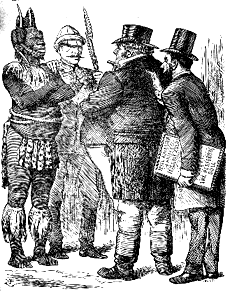

 Black 'White Elephant'" captures the essence of the definition of "white elephant." The cartoon depicts the seizure of the Zulu king, Cetewayo. The artist portrays Cetewayo with garments that the English would have called "savage." Most of his body is naked, and the few coverings that he does wear are crafted from the natural "fabrics" found in the jungles of Africa. His facial features, stereotypically African, include a flat, broad nose, thick lips and a sloping forehead. All of these elements would lead an Englishman of the nineteenth century, educated in the science of phrenology, to the immediate conclusion that Cetewayo is a wild, primitive and uncivilised creature who remains at a lower stage of evolution than his captors. The other men in the drawing, however--Major Marter, John Bull and "the Great Farini"--are far more uncivilised than is Cetewayo. As Punch points out, Marter's and Cetewayo's names were often transformed so as to create puns regarding "the Martyr ketching Ketchwayo." Although Marter is silent in the cartoon, as most martyrs are, Bull and Farini bring us to the issue of prejudice: they see Cetewayo as an object rather than a human being. Bull treats Cetewayo as a "white elephant," a property demanding much attention and expense while returning very little profit. Farini, who was a coordinator of exhibits for the Aquarium, degrades Cetewayo even further by suggesting that he be put on display, along with "Zazel, the Performing Bull." Cetewayo, however, with his arms crossed and his bare-footed but firm stance, defies his booted captors with his wide-open and piercing eyes, rendered all the more powerful against the hidden eyes and shallow sight of his captors.
Black 'White Elephant'" captures the essence of the definition of "white elephant." The cartoon depicts the seizure of the Zulu king, Cetewayo. The artist portrays Cetewayo with garments that the English would have called "savage." Most of his body is naked, and the few coverings that he does wear are crafted from the natural "fabrics" found in the jungles of Africa. His facial features, stereotypically African, include a flat, broad nose, thick lips and a sloping forehead. All of these elements would lead an Englishman of the nineteenth century, educated in the science of phrenology, to the immediate conclusion that Cetewayo is a wild, primitive and uncivilised creature who remains at a lower stage of evolution than his captors. The other men in the drawing, however--Major Marter, John Bull and "the Great Farini"--are far more uncivilised than is Cetewayo. As Punch points out, Marter's and Cetewayo's names were often transformed so as to create puns regarding "the Martyr ketching Ketchwayo." Although Marter is silent in the cartoon, as most martyrs are, Bull and Farini bring us to the issue of prejudice: they see Cetewayo as an object rather than a human being. Bull treats Cetewayo as a "white elephant," a property demanding much attention and expense while returning very little profit. Farini, who was a coordinator of exhibits for the Aquarium, degrades Cetewayo even further by suggesting that he be put on display, along with "Zazel, the Performing Bull." Cetewayo, however, with his arms crossed and his bare-footed but firm stance, defies his booted captors with his wide-open and piercing eyes, rendered all the more powerful against the hidden eyes and shallow sight of his captors.
[Victorian initial "A" by Harlan Wallach ęcopyright 1994.]